There needs to be a category between common and rare particularly for species that are not rare but aren’t seen often. Polygala are a good example: You never see them except in April in pine flatwoods. You have to be in the right place at the right time and we were this weekend.
At Wickham park in Melbourne we found some “candyroot,” a few short orange ones and several tall yellow ones growing beside a drainage ditch. Colorful, distinctive, aromatic, they were important in the religious beliefs of the Miccosukee Indians. Polygalas break down into two groups for our purposes, those whose roots have methyl salicylate (and smell of wintergreen or liquorish) and those that don’t. They had medicinal uses and were also thought of as candy hence the same. You can read more about this unusual genus here.
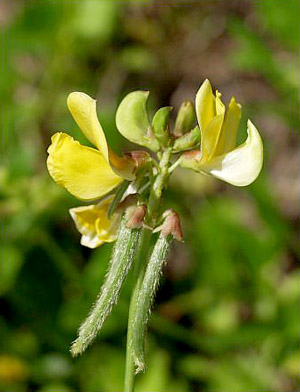
Hairy Cowpea is related to the mung bean. Photo by Regional Conservaion.org
If you are wandering around damp spots (as I was in Port St. Lucie Sunday for the Treasure Coast Environmental Education Council) look for the bright yellow blossoms of the Hairy Cowpea. They are closely related to Mung Beans and Black Eyed Peas. The blossoms are edible raw or cooked but are usually cooked. The seeds are edible cooked (not the pods.) Whenever you are near fresh water in Florida with a shrubby shore you are likely to find the Hairy Cowpea. And while one would not imagine so some folks confuse it with the common primrose willow which also had a yellow blossom. The primrose willow (which is neither a primrose nor a willow) is a shrub with a large four-petalled blossoms. The Hairy Cowpea has a small pea blossom, with “wings and keel.” Quite different. You can read about the Hairy Cowpea here.
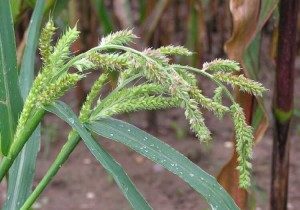
Barnyard Grass grows in damp areas. Photo by Find Duck Food.
The Education Council’s location was graced with a large amount of Purslane and Amaranth which probably came in with landscaping soil. One odd interloper in the parking lot turn around island was Barnyard Grass. I say interloper because Barnyard Grass usually likes to grow in damp places but perhaps there had been a lot of rain there lately. It’s an easy grass to identity: Barnyard grass is found in wet spots (usually) has a purple lower stem that’s often grows like a J, and does not have a ligule where the leaf blade separate from the main stem. Apparently it is the only grass in North America that does not have a ligule which helps in identification. From a human point of view the seeds can be used like wheat. You can read more about Barnyard Grass here.
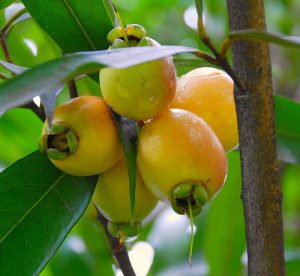
The Rose Apple by any other name tastes as sweet. Photo by The Fruit Warehouse
The good folks of the Treasure Coast Environmental Education Council held two classes Sunday at two locations providing a look at Florida as it is and what was a nice homestead by the river. I think I will be holding future classes at the preserve location (which is also just a few miles from the junction of the interstate and turnpike.) While at the homestead there was a tree whose identification was in doubt. One person said she thought it was a “rose apple.” My guess was Syzygium. I think we were both right. I think it might of been Syzygium jambos which is also called Rose Apple. Unfortunately the tree was either hit by cold weather at the wrong time or has some disease in that the fruit and foliage was damaged which did not help identification. The genus name, Syzygium, has marital connotations in Greek. To read more about the tree you can click here.
New Article archived: Tropical Almond
What do these wild edible plants have in common: Water Hyacinth, Air Potato, Skunk Vine and Garlic Mustard? They have or soon will have some insect trying to make them extinct in North America. Forager have competition so eat them while you can!
Water Hyacinth is a multi-million dollar pest in warm water ways. It affects water traffic, water quality, pumping, hydro electric operations and contributes to fish kill. Great hopes have been placed on Megamelus scutellaris, a plant hopper from South America. Released in 2010 I have not found follow up reports on the success of the bug. They are not expected to bother Pickerel Weed, a native and close relative of the Water Hyacinth. The latter species was intentionally released in the late 1800’s into Florida’s water ways.
Skunk Vine, intentionally brought to the state as a plant for making rope, may find its seasons numbered by a beetle from Thailand, Himalusa thailandensis. Only one tenth of an inch long the bug does a good job of killing off closely related species to skunk vine. There is no native insect in North America that feeds on skunk vine so hopes are high for the little bugger.
Released last fall to control the “Air potato” was the leaf beetle Lilioceris Cheni from China. In Davie, Florida, where they have liberated the Lilioceris on a limited basis they did have a local impact. The concern among foragers is that while intended to control the mostly non-edible Dioscorea bulbifera they will probably attack the Dioscorea alata as well. The latter has a highly edible root and is prime in Florida as a foraged caloric staple.
Garlic Mustard, Alliaria petiolata, is the sole food source for a small weevil with the large name of Ceutorhychus scrobicollis. First discovered in the New World on Long Island in 1868 it has invaded 34 mostly northern states. It is edible though most official news releases say while it is edible it is rather poor as said. A northern university is close go getting permission to let the weevil get garlic breath.
Florida is ground zero for not only introduced plants that turned bad but also bio-controls that went awry. was brought in to drain the everglades, bufo toads to control sugar cane pests (no one noticed the toads didn’t jump high enough to catch certain bugs) and blue tilapia to clear canals of weeds…. at least the tilapia are readily edible but they don’t take a hook. The toads are edible, too, but have to be cleaned correctly which includes removing the skin and parotoid glans. The glands are at the back of its head, behind the ears. They secrete a milky liquid that can burn your eyes and irritate your skin. The secretion can kill cats and dogs if they ingest it… see, yet another failure in that the toad has not had a major impact on the dog or cat population…
Next week: How to tell our two sow thistles apart.

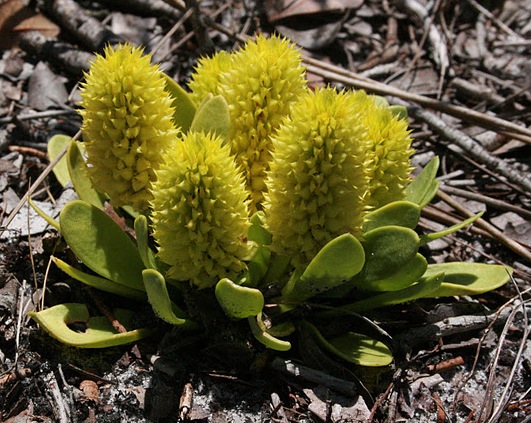
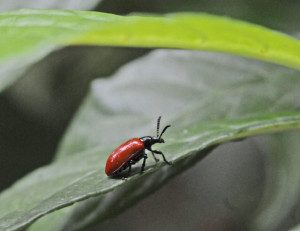
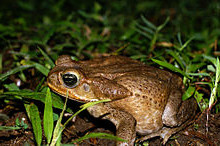

Thanks again for the class, Deane. I always learn something from your classes.
I was happy to finally get my city-girl wife outside looking at plants as though they were useful. She never believes a thing I say about what you can and cannot eat, something to do with my growing up in West Virginia and eating everything.
You have her looking around with a new respect for the plants around us…and for me for actually knowing some of them. Thanks for the class…and the backup!
I’m happy to hear to may start offering classes at the new location in the future.
Peace,
db
Hi Deane,
The syzygiums can be particularly confusing by common name. You got this one correct. The term “Rose Apple” 90% of the time refers to syzygium jambos (“pomarosa” in Latin America). Sometimes based on Latin name this species is confused with the Jambolan, or Java Apple, syzygium cumini, a rather invasive tree in Florida with bountiful sweet/astringent purple fruits. To make things more confusing “Rosewater Apple” is a common name of Syzygium samarangense, more commonly the Java Apple or Wax Jambu. A sister fruit which has a nearly identical fruit is the Mountain Apple, Syzygium malaccense, somehow the only one to actually have “apple” in it’s Latin name.
I know the garlic mustard is edible… but are you saying the weevil is also edible. That would be like steak and potatoes!
I love rose apples! They grow great in Ft. Lauderdale, but many years get terrible rust that is particular to myrtles. Never know if it’ll be a good crop…. doesn’t kill the tree, but damages leaves and fruit. I’m not sure of a way to treat for it….
Would Love To See You Come To Port Saint Lucie!!!!
When I was growing up in Central Florda, Pre-Disney days, and before the severe freezes of the mid ’80’s, there were guavas everywhere growing wild and in nearly everyone’s back yard. There were two varieties: the common large yellow guava, and a smaller guava that usually turned crimson color when ripe. The smaller red guava was coloquelly called Catholic Guava, also Cat-Lick Guava, but occasionally called a Rose Apple.
I don’t know if this is the same as the Syzygium, but since the photos of the fruite and leaf look very similar to the Cat-Lick Guava, and the fruit also has a crown, I wonder if you know of any relation of the plants? The Cat-Lick guava has a verry distinctive guava aroma and flavor , but as kids we discovered the guavas by following the Shrub’s apparent aroma of roses.
Thanks, and keep up the great work you are doing.
Chaz Mikell
P.S. I hope you can find time to make a trip to Southeast Mississippi. I recently discovered the 18,000 acre Grand Bay National Eastuarine Research Reserve, and the diversity of plant life is unbelievable.
Yesterday on my way back from Gainsville via rt. 26 and rt. 100 I saw lots of Paw Paws, just in case you are looking for some. Plus today i had some earth friendly friends over and was sharing the forging knowledge with them, more prospective students for your classes, lol.
Thanks for coming to Fort Pierce. It was great fun to walk with you.
I had no idea Buffo toads were weeds…
Please don t eat them!
Actually the name of the website is “Eat The Weeds and other things, too.” There are articles on turtles (get a lot of hate mail over that) snails, slugs, jellyfish, et cetera.
syzzgium is a word that cannot be typed without typos
Up here, we’ve got Garlic Mustard out the yin- yang! I use it from now until January (hard pack snow)…
Terrific pesto!
Oh, I should mention I am a chef.
Although I understand there are detrimental effects of water hyacinth overgrowth, I also understand the beneficial effects of that same plant when grown in a confined area for use in the compost heap. SWIM (Someone Who Isn’t Me) kept generations of it growing in a big goldfish pond for exactly that reason — the plant’s ability to provide a reliably prolific, renewable source of material for use as a soil amendment along with other composted greens. The earthworm population explosion in the Gardens of SWIM did not go unnoticed, nor could the the ability of the soil to hold moisture more efficiently be ignored.
Considering biocontrol, it is worthwhile to mention the dual role played by the grass carp fish introduced to Sudan and has been reported to ingest vast numbers of Biomphalaria snails as well as Potamogeton (pond weed) in which it feeds. This is related to the fight against “Shistosmiasis also called “Bilharziasis” disease – wide spread in Nilewater irrigated areas in both Sudan and Egypt – as well as against “Malaria” disease. Humans act as intermediate hosts in such diseases. About Cowpeas, I would rather now say a word about Vigna unguiculata well known in my country and refer to it again where more appropriate. Interestingly in Sudan it is generally grown with Sorghum Sudan “Dura” for the purpose of together providing high amount of biomass which consequently degrades to organic matter required to nourish worn-out soils , not to forget its use as increasing fertility in the soil due to the nitrogen fixing bacteria in the root nodules.